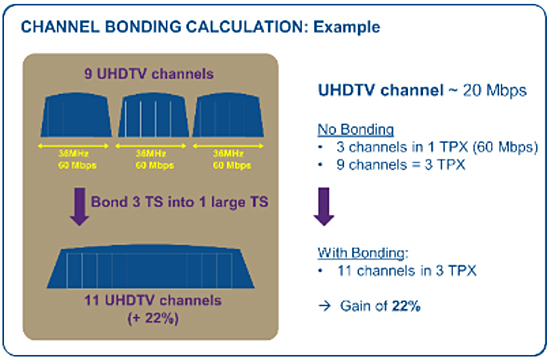Channel bonding allows the Service Provider to bond transmission capabilities across the same link to deliver higher throughput for select remote sites.
We developed channel bonding capabilities for broadcasting,fixed and mobility networks.
Channel bonding allows the Service Provider to bond transmission capabilities across the same link to deliver higher throughput for select remote sites.
We developed channel bonding capabilities for broadcasting,fixed and mobility networks.

According to the DVB-S2X standard, Channel Bonding for Transport Stream (TS) transmissions splits a TS in two or three parts for parallel transmission over satellite. The receive part recomposes the original TS, meaning that multiple carriers can be combined to act as one very large carrier.
For ultra-high-definition (UHD) television, only three or four channels would fit on a 36 MHz transponder. The statistical multiplexing gain of seven UHD channels composing a Direct-to-Home (DTH) bouquet can only be obtained through the Channel Bonding of two carriers, as the bit rate exceeds what is available in a single Ku-band Transponder Equivalent (TPE) of 36 MHz.
The efficiency gain of statistical multiplexing on seven channels is typically 20%.
For a use case where only three programs fit into one bouquet to fully load a 36 MHz transponder – meaning that for nine programs, three transponders would be required – the DVB-S2X standard allows the creation of a single transport stream and splits these programs over three 36 MHz transponders. Due to statmux gains, it is possible to add two more programs into the same bouquet on the same transponders.

XipLink and ST Engineering iDirect have teamed together to create a unique solution that unites the power of two modems to meet the most demanding applications. This solution allows to channel bond and link balance two modems together, doubling the combined TCP/ IP downstream and upstream data rate capacity across the same link to deliver extreme throughput for select remote sites.
Plus, the solution offers additional XipLink optimizations, such as header and payload transmission compression, Space Communication Protocol Specification (SCPS) for TCP acceleration, and advanced website data compression. The benefits are: